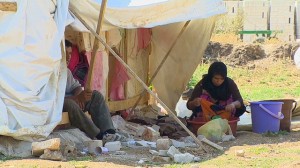 International donors must do more to help Lebanon absorb a flood of refugees straining its schools and public services, the head of the United Nations children’s fund UNICEF said.
International donors must do more to help Lebanon absorb a flood of refugees straining its schools and public services, the head of the United Nations children’s fund UNICEF said.
Lebanon, the smallest of Syria’s neighbors, is giving sanctuary to the largest number of refugees from the civil war across its border and Syrians now number around a quarter of its own population of just over 4 million.
With a weak government and threadbare national services even before the Syrian crisis erupted two and a half years ago, Lebanon is struggling to support those refugees, scattered in informal camps across the country’s most deprived areas.
“Lebanon has opened its borders, opened its arms, and the international community owes it to Lebanon to do everything it can to help Lebanese society adapt to this,” UNICEF chief Anthony Lake told Reuters on a visit to a camp in the eastern Bekaa Valley, about two miles from the Syrian frontier.
The United Nations says 800,000 Syrians have either registered or are awaiting registration as refugees in Lebanon. But many more are estimated to be in the country unregistered and some Lebanese officials say there could be more than 1 million refugees in the country.
The World Bank has estimated the cost to Lebanon at around $2.6 billion over three years. Government-funded schools, which cater for the poorest third of the population, face being inundated with Syrians even if only a fraction of them enroll.
Lake visited a Bekaa Valley school where 200 of the 355 children are Syrian and the kindergarten section has swollen to around 40 per class.
“Physically we are able to absorb them but at some stage we will need more teachers and equipment,” head teacher Jhonny Abu Toumah said. “What else can I do with the children – put them out on the street?”
Lebanese Education Ministry figures show 26,000 Lebanese children were enrolled in government schools in the Bekaa Valley last year, along with 7,000 Syrians. Another 14,000 Syrians are waiting for places in additional afternoon shifts.
But most are being taught, if at all, in the camps.
“(The scale) is huge and there are 400,000 children from Syria now in Lebanon – next year it could grow to double that,” Lake said after watching volunteers teaching children at Kfar Zabad camp, which houses 2,000 people in plastic and canvas tents beside the mountain range dividing Lebanon from Syria.
“This is going to be a huge burden on the Lebanese school system … There are as many Syrians of school age as there are children now in the Lebanese public schools.”
Lake, who also visited Syria and Jordan, which houses the largest Syrian refugee camp at Zaatari, said pictures he had seen drawn by children there showed images of hopelessness, violence and revenge.
“The danger long term is this will be recycled in the next generation,” he said. “If we can’t change what’s in their hearts … this is going to be perpetuated in the next generation, with dire consequences not just for Syria but the whole region.”
Reuters
Leave a Reply
You must be logged in to post a comment.